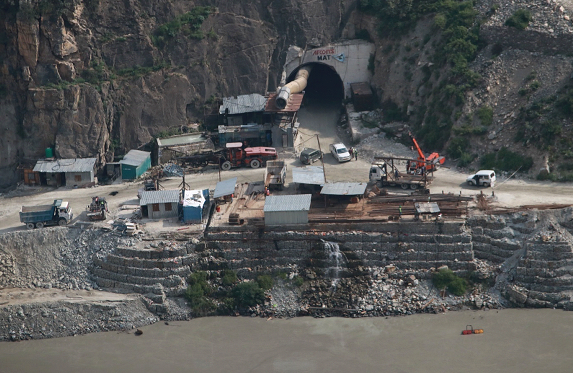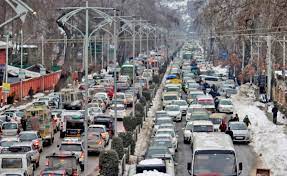Power Vs Precarity in the Himalayas
By: Javid Amin | 01 Sep 2025
The Chenab Valley of Jammu & Kashmir, often described as the “powerhouse corridor” of North India, is at the heart of India’s clean energy dreams. With roaring rivers, steep gradients, and vast untapped hydropower potential, Kishtwar district has become the focal point of multi-billion-rupee energy investments.
At the center of this transformation are four flagship hydropower projects—Pakal Dul, Kiru, Kwar, and Dangduru—valued at over ₹22,535 crore. Spearheaded by Chenab Valley Power Projects Private Limited (CVPPL), these dams and power stations promise to inject thousands of megawatts of clean energy into India’s national grid.
Yet, beneath the optimism lies a stark warning. A recent risk assessment report has declared these projects as “high risk”, citing their proximity to fragile glacial lakes and growing vulnerability to Glacial Lake Outburst Floods (GLOFs).
The stakes could not be higher. At risk are not just the projects themselves, but entire communities, fragile ecosystems, and the broader future of sustainable infrastructure in the Himalayas.
The Projects at Risk
CVPPL’s Flagship Ventures
Chenab Valley Power Projects Private Limited (CVPPL) is a joint venture between NHPC (National Hydroelectric Power Corporation), JKSPDC (Jammu & Kashmir State Power Development Corporation), and PTC India. Together, they aim to transform Kishtwar into the hydropower capital of J&K.
Here’s an overview of the projects currently in focus:
| Project | Capacity (MW) | Estimated Cost (₹ Cr) | Status |
|---|---|---|---|
| Pakal Dul | 1,000 MW | 12,669.67 | Under construction |
| Kiru | 624 MW | ~5,300 | Near commissioning |
| Kwar | 540 MW | 4,526 | In progress |
| Dangduru | TBD | TBD | Planning stage |
These projects are seen as lifelines for India’s renewable energy push, with the potential to supply electricity to millions of homes. For a power-starved state like J&K, they also represent job creation, regional development, and infrastructure modernization.
However, their location—deep inside the fragile Himalayan terrain of Kishtwar—makes them uniquely vulnerable. The Chenab River basin is prone to landslides, seismic activity, cloudbursts, and flash floods, all of which compound risks for hydropower infrastructure.
Lessons from Elsewhere
Similar projects in Himachal Pradesh, Nepal, and Bhutan have faced devastating setbacks due to climate-linked disasters. For instance, the 2013 Kedarnath floods in Uttarakhand wiped out multiple hydropower projects overnight. Bhutan, on the other hand, has pioneered GLOF early warning systems after facing repeated threats.
The Kishtwar projects, therefore, sit at the crossroads of opportunity and danger—a test case for whether India can truly balance development with climate resilience.
The Climate Threat – GLOFs Explained
What Are Glacial Lake Outburst Floods?
Glacial Lake Outburst Floods (GLOFs) occur when glacial lakes—formed by the melting of retreating glaciers—suddenly release vast amounts of water. These lakes are typically dammed by fragile ice or loose moraine deposits, which can collapse under stress.
When this happens, the results are catastrophic:
-
A torrent of water, mud, and debris rushes downstream.
-
Entire villages, bridges, and farmlands are swept away.
-
Dams and turbines face immense hydraulic shock, often leading to collapse.
-
Rivers swell beyond capacity, triggering secondary floods.
In short, a single GLOF can undo decades of investment and wreak havoc on communities.
Why Kishtwar is at High Risk
Kishtwar district has 197 identified glacial lakes—the highest number in Jammu & Kashmir. Climate studies reveal that many of these lakes have expanded alarmingly in recent decades due to accelerated glacial melt.
The GLOF Management Plan for Kishtwar (2024–25) identifies five tehsils as particularly vulnerable:
-
Padder
-
Machail
-
Dachhan
-
Marwah
-
Warwan
These regions are not only home to low-lying settlements and pilgrimage routes but also to critical infrastructure like roads, powerhouses, and even the Kishtwar High Altitude National Park, a biodiversity hotspot.
A Glimpse into Disaster
On August 14, 2024, a cloudburst in Padder tehsil killed 65 people during the annual Machail Mata yatra. The tragedy underscored how fragile and exposed the region is to sudden weather extremes. Scientists warn that a GLOF could unleash destruction on an even larger scale, particularly if it impacts major dams.
Infrastructure at Stake
What Could Be Lost
If a major GLOF were to strike, the consequences could be devastating:
-
Dams & Turbines: Critical assets worth thousands of crores could be severely damaged. Repairing or rebuilding them would take years.
-
Roads & Bridges: The Jammu–Srinagar National Highway, already vulnerable to landslides, could face prolonged blockages. Rural connectivity would collapse.
-
Transmission Lines: Power evacuation corridors could be wiped out, halting electricity supply.
-
Villages & Towns: Settlements along the Chenab’s floodplain would face inundation. Displacement, property loss, and casualties would follow.
-
Water Quality: Floodwaters often contaminate drinking supplies with silt, chemicals, and debris.
-
Biodiversity: The Chenab Valley’s unique ecosystems, including endangered species in Kishtwar National Park, would suffer irreversible damage.
The Human Dimension
Behind every hydropower statistic lies a human story. Farmers who depend on river water, families living in low-lying hamlets, and pilgrims traveling to shrines are all in the path of potential destruction.
This is why experts stress that climate resilience must be at the heart of energy planning—not an afterthought.
Scientific Basis and Risk Indicators
Why These Projects Are Vulnerable
The risk assessment cites multiple scientific concerns:
-
Proximity to Multiple Glacial Lakes at different altitudes, increasing the chance of cascading floods.
-
Accelerated Glacial Retreat due to rising Himalayan temperatures.
-
Unstable Moraine Dams—natural barriers that are highly prone to collapse.
-
Seismic Activity—Kishtwar lies in a seismically active zone where earthquakes could trigger lake breaches.
-
Sediment Build-up that adds pressure to lake walls.
High-Risk Lakes Identified
-
Mundiksar Lake – Classified as “high risk” due to its growing volume.
-
Hangu Lake – Another “high risk” lake with fragile moraine walls.
-
Palta Pani Lake – Moderate risk, but large enough to cause significant flooding if breached.
-
Unnamed Lakes – Several smaller but expanding lakes remain under-monitored.
Satellite data shows these lakes are expanding by several hectares each decade, signaling an urgent need for surveillance.
Mitigation and Reform Imperatives
What Needs to Be Done
Experts recommend a multi-pronged strategy:
-
Continuous Monitoring – Using satellites, drones, and ground-based surveys to track glacial lakes.
-
Early Warning Systems – Automated sirens, alerts, and mobile-based warnings to reach vulnerable villages.
-
Drainage & Reinforcement – Controlled drainage of high-risk lakes and engineering reinforcement of moraine dams.
-
Climate-Resilient Infrastructure – Designing dams and turbines to withstand sudden water shocks.
-
Integrated Disaster Planning – Coordinated action between energy, environment, and disaster management departments.
A Himalayan Infrastructure Resilience Framework
The report calls for a comprehensive framework combining engineering innovation, ecological safeguards, and community preparedness. This would include:
-
Building redundant evacuation routes in disaster-prone valleys.
-
Training local communities in first response and disaster awareness.
-
Ensuring transparent communication between project developers and local populations.
A Call to Policymakers
Balancing Energy and Ecology
India’s clean energy mission is essential for reducing carbon emissions and achieving climate targets. But it cannot come at the cost of human safety and ecological collapse.
Policymakers must now confront tough questions:
-
Should hydropower projects in high-risk Himalayan zones be scaled back or redesigned?
-
Can alternative renewable sources—like solar and wind—play a bigger role in J&K’s energy mix?
-
How can communities be made stakeholders in resilience-building, rather than victims of poor planning?
The Way Forward
-
Reassess Project Timelines – Factor in climate risks before fast-tracking commissioning.
-
Invest in Adaptation Strategies – Build long-term climate adaptation plans for the Chenab Valley.
-
Empower Local Communities – Provide training, resources, and participation in monitoring systems.
-
Global Partnerships – Learn from Bhutan, Nepal, and Switzerland, which have pioneered GLOF risk reduction.
Final Editorial Summary
Kishtwar’s ₹22,535 crore hydropower portfolio was meant to power India’s clean energy future. Today, it stands at the crossroads of ambition and vulnerability. With the looming threat of glacial lake outburst floods, the region faces a climate reckoning that cannot be ignored.
This is not just about dams and turbines—it’s about lives, landscapes, and long-term resilience.
If India wishes to lead in renewable energy, it must also lead in climate preparedness and ecological foresight. The Chenab Valley’s story is a warning and an opportunity. The time to act is now.



